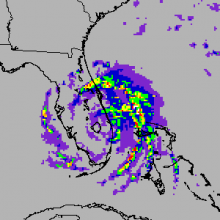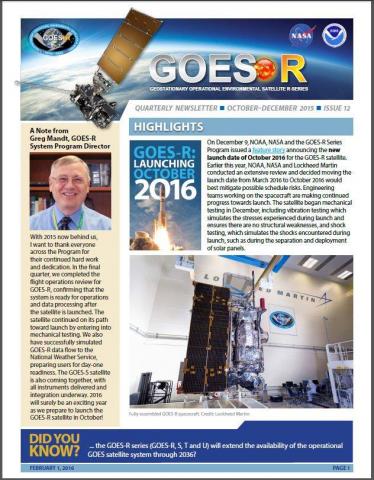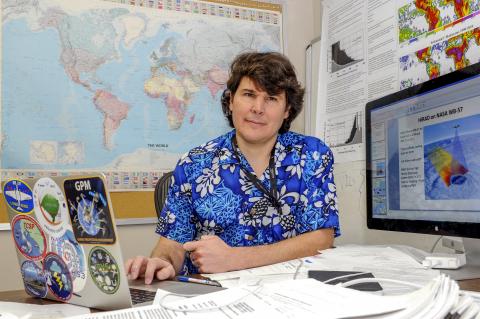Have you ever wondered where the most lightning strikes occur on our planet? As it turns out, Lake Maracaibo in Venezuela earns top honors for the highest number of lightning strikes in a square kilometer, also known as lightning density. This phenomena is creatively explained in a new TED-Ed Lesson called “The most lightning-struck place on Earth” by Graeme Anderson. The lesson includes a ‘Dig Deeper’ section that explains where lightning strikes most. This section includes a description of the Optical Transient Detector (OTD) and the Lightning Imaging Sensor (LIS), two space-based sensors whose data is distributed at the Global Hydrology Resource Center (GHRC), one of NASA’s Distributed Active Archive Centers (DAAC). Check out the TED-Ed Lesson here: http://ed.ted.com/lessons/the-most-lightning-struck-place-on-earth-graeme-anderson and download lightning data from the GHRC here: https://ghrc.nsstc.nasa.gov/lightning/.
GHRC News
Lead software developers Ajinkya Kulkarni of GHRC DAAC and Daine Wright of ORNL DAAC had a face-to-face meeting on January 26 at GHRC to discuss ORNL’s Semi-Automated data ingest System (SAuS) and GHRC’s metrics dashboard. This meeting enabled the developers to review both software systems in depth, in order to facilitate transfer of each technology to the other DAAC.
Please note: SAuS is now called DAPPeR and can be found at https://ghrc.nsstc.nasa.gov/data-publication/
 The AMSR-E Science Investigator-led Processing System (SIPS) at the GHRC DAAC completed full mission reprocessing of the AMSR-E Level-2 Rain data, browse, and GIBS imagery on January 22, 2016. The new version 3 dataset is available to users from the NSIDC DAAC.
The AMSR-E Science Investigator-led Processing System (SIPS) at the GHRC DAAC completed full mission reprocessing of the AMSR-E Level-2 Rain data, browse, and GIBS imagery on January 22, 2016. The new version 3 dataset is available to users from the NSIDC DAAC.
 International Space Station Lightning Imaging Sensor (LIS) Principal Investigator Richard Blakeslee and members of the Global Hydrology Resource Center DAAC are in this issue of the GOES-R (Geostationary Operational Environmental Satellite - R Series) Series Quarterly Newsletter, covering Oct - Dec 2015! See feature on p. 3 “Proving Ground and Program Science” at
International Space Station Lightning Imaging Sensor (LIS) Principal Investigator Richard Blakeslee and members of the Global Hydrology Resource Center DAAC are in this issue of the GOES-R (Geostationary Operational Environmental Satellite - R Series) Series Quarterly Newsletter, covering Oct - Dec 2015! See feature on p. 3 “Proving Ground and Program Science” at
http://www.goes-r.gov/resources/newsletters/docs/GOES-R_Q42015.pdf
"During December 1-15, GHRC DAAC staff and the MSFC Lightning Science Team supported a Payload Rack Checkout Unit (PRCU) for ISS LIS and other instruments in the DoD STP-H5 (Space Test Program-Houston 5) package. The ISS-LIS will be flown as a hosted payload on the STP-H5 mission, which is scheduled for launch in summer 2016 aboard a SpaceX launch vehicle for a 2-4 year or longer mission. In this test we received simulated LIS observations, instrument housekeeping data, ISS ephemeris and Star Tracker data, verifying data ingest networks and software."
Find more about lightning research and data at https://ghrc.nsstc.nasa.gov/home/projects/lightning

Why is it important to study hurricanes?
Hurricane Katrina caused upwards of 2,000 deaths and $100 billion in damages in 2005. It could have easily been much worse. A few historic hurricanes in India and Bangladesh have caused more than 100,000 deaths each. We will never eliminate all the deaths and damage from hurricanes. But the more we know about their structure, and the better we can forecast them, the more we can limit those impacts.
Dan addresses this and other questions at https://www.nasa.gov/centers/marshall/about/star/star160120.html#three.







